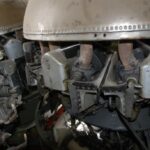Trolley accumulators on the Thistlegorm
Trolley accumulators on the Thistlegorm
A number of dive guides will tell you that you can see motorcycle sidecars on SS Thistlegorm. In fact, these odd-looking contraptions are trolley accumulators.
Trolley accumulators were produced in several forms, but they all had a bank of lead/acid batteries contained in a covered box, which had been wired ‘in series’ so that each lead/acid cell (nominally producing about 2 volts) produced 12 volts and sufficient power to turn over the standard aircraft engines of the day. The reason it is called an ‘accumulator’ is because some early batteries could not be recharged using an electrical current and needed to have their electrolyte renewed after discharge! In 1881, the standard sulphuric acid/lead plate battery (approximately one volume of concentrated to five volumes of distilled water) was revolutionized by the use of lead grids, into which lead oxide paste was pressed. If you connect the negative terminal of an electrical circuit to one plate, and the positive to the other, then electrons will be ‘forced’ into the -ve plate, making it contain a higher proportion of pure lead, and ‘stripped’ from the +ve plate, making it contain more lead oxide. Theoretically, therefore, in a fully charged battery, you should end up with a -ve plate of pure lead (Pb, and rather nice slate blue colour), and a +ve plate of pure lead oxide (PbO2, a rather sludgy brown); the liquid electrolyte flowing around them should be a much weaker mixture of sulphuric acid. As the ‘accumulator’ discharges, the exact opposite of the above process happens.
When not in use these trolley accumulators were connected to the mains electricity supply at the RAF station they were on, to build up charge (usually overnight); they would need periodic servicing, and topping up with distilled water, as they tended to lose that component of the electrolyte during the charge/discharge process. You may have observed that this ‘trolley acc’ has what appears to be an engine on top of it. This is because on remote sites, the small generator set/control panel mounted directly to the right of the engine’s cylindrical fuel tank, and capable of producing about 300 watts, would then be able to recharge the batteries fitted below it. This was also used if the ‘trolley acc’ had been used a lot during the day, or in cold weather. As a rough guide, for every 1 degree Centigrade drop in temperature, you lose about 3% in maximum available electrical charge. To access the batteries, you unbolted the engine/generator set, and two men lifted it off the battery compartment lid.
There are other aviation finds that I located on this classic wreck, including:
Blenheim bomber engine exhaust rings and tail planes





Leave a comment